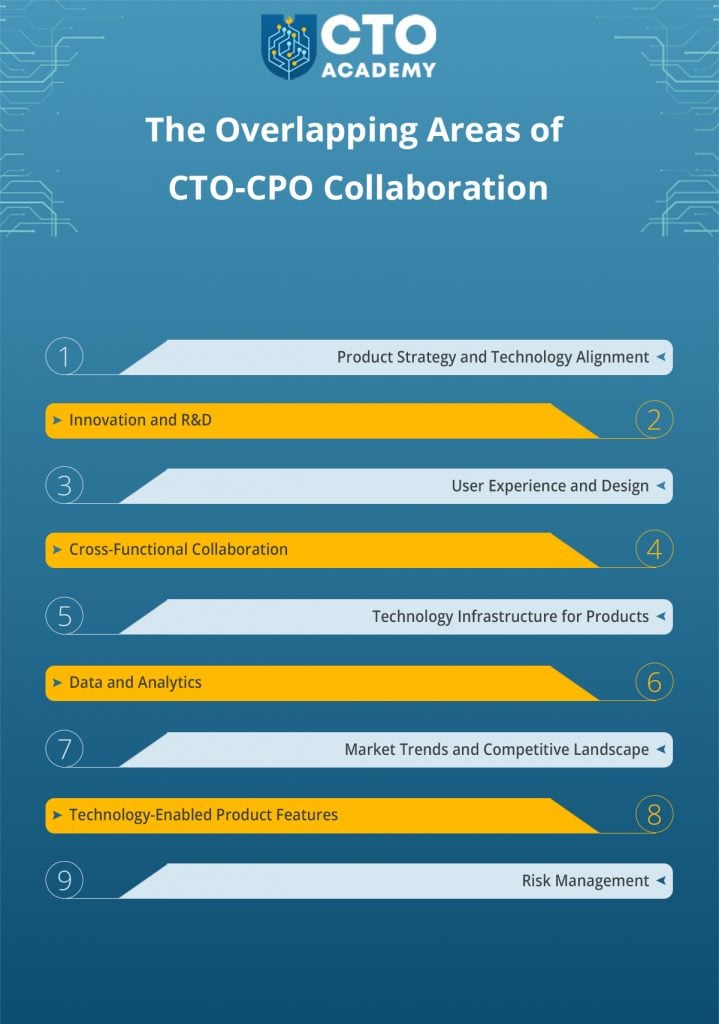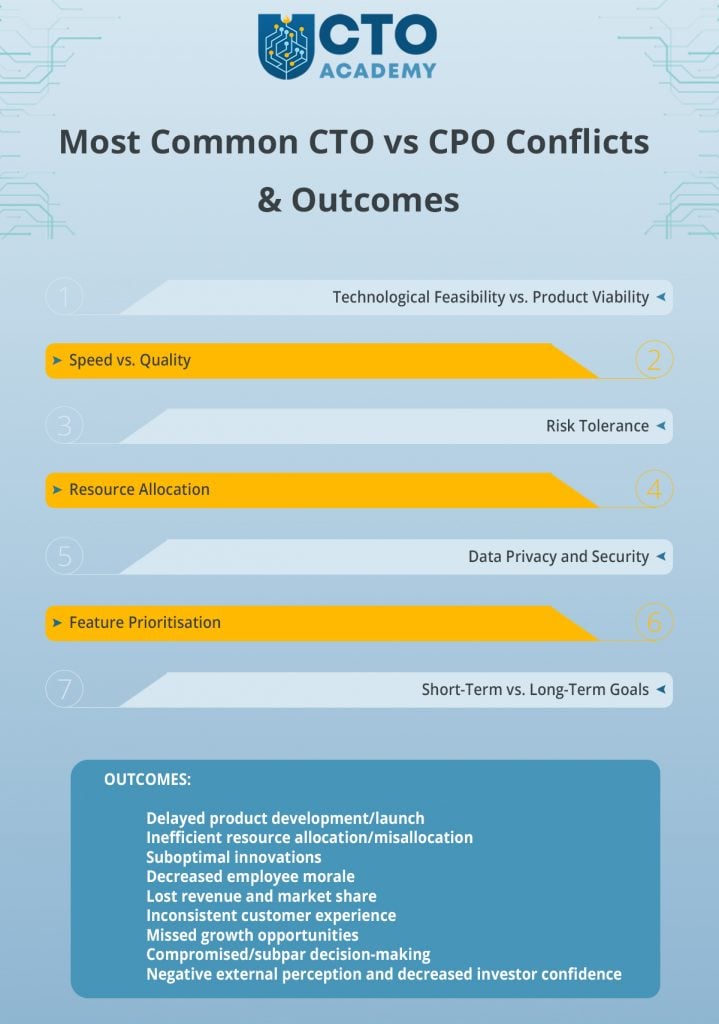Chief Technology Officers (CTOs) and Chief Product Officers (CPOs) are at the heart of most growing companies. Two distinct but closely connected roles that converge technology and innovation.
When successful, this synergy becomes a critical success factor harmonising innovation and excellence.
In this blog post, we explore both roles and where they intersect. Most importantly, we explore the strategies that help foster effective collaboration and resolve some of the inevitable conflicts that can block growth.
Both roles have evolved beyond their traditional definitions.
Gone are the days when CTOs focused solely on technical infrastructure and CPOs on product development.
Technology is no longer a support function and cost centre; it’s an integral driver of the business and product innovation.
Similarly, products are not standalone entities; they are intricate amalgamations of technology, design and user-centricity.
The CTO once confined to managing IT and technical operations, is now expected to wield expertise as a strategic visionary entrusted with aligning technological advancements with business goals, identifying opportunities to leverage emerging technologies and integrating tech-driven solutions into product offerings.
Concurrently, the role of the CPO has expanded far beyond managing product development cycles. They’re now the architects of user experience, weaving together technology and design to craft compelling products. The CPO brings a customer-centric lens to product ideation, collaborating closely with the CTO to understand the possibilities that technology can unlock and, ultimately, align these possibilities with market demand.
It is important to acknowledge that the Chief Product Officer (CPO) is typically not considered an integral part of the CTO office. They can closely collaborate and even share goals, but they usually belong to separate departments within an organisation.
While there can be some overlap in responsibilities, they generally have distinct focuses and areas of expertise.
The CTO is primarily responsible for the technology vision, strategy and execution within the company. They are focused on aligning technology initiatives with the organisation’s business goals, ensuring that the technology infrastructure and solutions support growth and innovation. CTOs are also at the forefront of digital transformation.
Learn more about the responsibilities of CTOs in start-ups and fast-growth companies.
Besides managing the development team and exploring the impact of new technologies, the CTO is also responsible for defining the technical roadmap for the company, outlining the technology stack, architecture and frameworks that will be used in product development. They make decisions about technology investments, partnerships, and vendor relationships.
Learn more about the role of a CTO in different business sizes.
The CPO is primarily responsible for product vision, strategy, development and management. They focus on creating and improving products that meet customer needs and align with market trends. During the process, the CPO works closely with cross-functional teams, including design, engineering, marketing and sales, to bring products from concept to market.
Unlike product managers who work in trenches managing specific products, CPOs hold a high-level strategic role overseeing the entire strategy and portfolio.
While we are on the subject of managers, it’s worth noting that the most common career path to the CPO role starts in the product team where those who demonstrate high interest and impressive leadership skills, get promoted to product management positions.
(The Chief Product Officer is also involved in product marketing, working closely with the Chief Marketing Officer.)
There are several areas where responsibilities can overlap due to the interconnected nature of technology and product development.

1. Product Strategy and Technology Alignment
The CTO’s insight into current and emerging technologies can help shape the CPO’s product roadmap and ensure that product ideas are feasible from a technical standpoint.
2. Innovation and R&D
While the CTO might focus on technological innovation, the CPO seeks to introduce innovative products that meet customer needs and stand out in the market.
3. User Experience and Design
The CPO conducts product analysis to create products that provide excellent user experiences. At the same time, the CTO ensures that the technology supports the design requirements and performance expectations.
4. Cross-Functional Collaboration
Both roles require collaboration with various departments, such as engineering, design, marketing and sales. They work together to bridge the gap between technical feasibility and market demand.
5. Technology Infrastructure for Products
The CTO oversees the technology infrastructure that supports product development, deployment and scalability. This infrastructure is crucial for ensuring that products can be efficiently built, tested and delivered.
6. Data and Analytics
The CPO may use data to inform product decisions, while the CTO might leverage data to optimise technology solutions and systems.
7. Market Trends and Competitive Landscape
The CTO’s knowledge of emerging technologies and trends can provide valuable insights for the CPO to develop products that stay ahead of the competition and address changing market demands.
8. Technology-Enabled Product Features
In some cases, the CTO might collaborate with the CPO to develop technology-enabled features that enhance the value of the product.
9. Risk Management
Both roles are involved in risk management related to their respective areas. The CTO might assess technical risks, such as security vulnerabilities, while the CPO considers risks related to product-market fit and adoption. Often, the risk identified by the CTO can affect the product and vice versa.
While overlapping obviously exists, it is important to recognise that the CTO and CPO roles have different primary focuses. Nonetheless, successful collaboration between these roles is crucial for a company’s overall success, as it helps align technology and product strategies to deliver innovative and market-leading solutions.
Collaboration between CTOs and CPOs goes beyond the alignment of roles; it unlocks a spectrum of advantages that fuel innovation and elevate product development.
Improved product-market fit
Collaboration bridges the gap between technological possibilities and customer expectations. The integration of cutting-edge technology with keen insights into market demands ensures that products resonate with users. This alignment boosts the chances of achieving a seamless product-market fit, increasing customer satisfaction and loyalty.
Innovative technology integration
Effective collaboration between CTOs and CPOs yields innovative breakthroughs. CTOs bring their technical acumen to the table, proposing solutions that push the boundaries of what’s feasible. When these solutions are integrated into product design under the guidance of CPOs, the result is a transformative product that differentiates the company from its competitors.
Faster Time-to-Market
The collaborative partnership expedites the product development lifecycle. As CTOs and CPOs align their strategies, decisions are made more efficiently, reducing delays. Technological feasibility and market alignment are considered simultaneously, allowing products to be brought to market quickly.
The main advantage of faster time-to-market is the company’s ability to capitalise on emerging opportunities.
CTOs and CPOs should collaborate in these four crucial areas:
Collaboration in these areas results in holistic product development.
When the CTO and CPO align technology and product roadmaps, they effectively merge technological insights with user needs. This convergence empowers them to create well-rounded products and ensures that technology-driven innovations align with market demands. They achieve this by successfully integrating technological advancements and customer requirements.
Combined with robust technology, this user-centric design creates a seamless user experience, thus enhancing user satisfaction. However, without close collaboration in this area, it would be nearly impossible to effectively balance tech capabilities and user satisfaction.
Finally, analytics-driven strategies lead to informed, impactful choices.
Overall, collaboration elevates product quality, resonates with customers and drives competitive advantage.
In a nutshell, there are only five steps CTOs and CPOs must follow:
Apple
Apple’s success is largely attributed to the harmonious collaboration between its CTO and CPO. The seamless integration of hardware, software and user experience in products like the iPhone exemplifies the synergy that drives innovation and captures market share.
Amazon
Amazon’s Kindle, a revolutionary e-reader, showcases collaborative leadership. The CTO’s technological insights combined with the CPO’s understanding of readers’ needs resulted in a product that transformed the publishing industry.
Tesla
The CTO’s expertise in electric propulsion coupled with the CPO’s emphasis on sleek design and user experience have redefined the automobile industry.
These and other examples prove that the symbiotic collaboration between CTOs and CPOs not only gives companies a strong competitive edge but can also reshape industries and revolutionise market landscapes. And the catalyst of that success is simply the alignment of technological innovation and customer-centric product development.
Then again, when two stratagems of such calibre collaborate, conflicts become inevitable.

Collaboration between Chief Technology Officers and Chief Product Officers isn’t without its challenges. Differing priorities and perspectives can lead to conflicts that, if not managed effectively, hinder the collective success of the organisation. Understanding these common conflicts that may arise is the first step toward constructive resolution.
Conflict #1: Technological Feasibility vs. Product Viability
CTOs often prioritise technological feasibility, aiming to implement cutting-edge solutions. In contrast, CPOs emphasise products that resonate with customers. Disagreements can occur when CTOs propose innovative features that CPOs deem unnecessary or complicated.
Conflict #2: Speed vs. Quality
CTOs may push for rapid technology deployment, seeking a competitive edge. Conversely, CPOs emphasise product quality and user experience, advocating for thorough testing and refinement. The conflict lies in finding the right balance between speed and excellence.
Conflict #3: Risk Tolerance
CTOs may be more willing to take calculated risks in adopting new technologies. CPOs, on the other hand, prioritise minimising risks to protect the user experience and brand reputation. This difference can lead to debates over embracing untested technologies.
Conflict #4: Resource Allocation
Conflicts arise when allocating resources like budget and manpower. CTOs may advocate for technology investments, while CPOs advocate for product development. Balancing these allocations requires compromise to ensure both sides’ objectives are met.
Conflict #5: Data Privacy and Security
CTOs focus on robust data privacy and security measures to protect user information. CPOs, concerned with user experience, may push for smoother user interactions that require data sharing. Balancing these priorities without compromising security can lead to friction.
Conflict #6: Feature Prioritisation
CPOs prioritise features aligned with market demands, while CTOs prioritise those that showcase technical prowess. Disagreements can arise when deciding which features have the advantage in product development.
Conflict #7: Short-Term vs. Long-Term Goals
CTOs might favour long-term technical infrastructure, while CPOs focus on short-term product releases. Balancing these goals can lead to discussions on how to invest resources for both immediate and future gains.
Once the synergy gets disrupted, the fallouts can lead to several negative outcomes:
Resolving conflicts effectively between a CTO and a CPO requires a combination of communication, collaboration and a commitment to finding common ground. Here’s a step-by-step guide on how they can address conflicts and work towards productive solutions:
Step #1: Acknowledge the conflict and its impact on the organisation.
Step #2: Create a safe space for open and honest communication.
Step #3: Both the CTO and CPO should actively listen to each other’s viewpoints to understand each other’s underlying concerns.
Step #4: Define the root cause.
Step #5: Remind each other of the shared goals and objectives.
Step #6: Seek compromise.
Step #7: Use objective data and evidence to support arguments and decisions.
Step #8: Brainstorm possible solutions while encouraging creativity and openness to different ideas.
Step #9: Assess the potential consequences of each solution.
Step #10: If feasible, test the proposed solution on a small scale before implementing it organisation-wide.
Step #11: Document the agreed-upon solution and outline the steps that will be taken to implement it.
Step #12: Monitor progress.
Step #13: If conflicts persist, consider involving a neutral third party, such as a higher-level executive or an external mediator.
While the iPhone was the brainchild of Steve Jobs, it was the collaboration between the CTO, Tony Fadell, and the CPO, Jonathan Ive, that brought this now iconic product to life.
Fadell was responsible for the technical aspects, such as the hardware design and the operating system. Ive, on the other hand, was responsible for the user interface and the design. The two of them worked closely together to create a product that was both technically advanced and user-friendly. It is a prime example of how successful collaboration between the CTO and CPO can lead to a successful product.
Now, let’s see the inner workings of this collaboration.
CASE STUDY: The company is planning to develop a new mobile app that incorporates cutting-edge features and technologies. The CTO and CPO need to collaborate to ensure the successful development and launch of the app.
STEP 1: Early Involvement and Ideation
→ The CPO shares the initial concept of the app with the CTO, highlighting the features and user experience they envision.
→ The CTO provides insights into the feasibility of implementing certain technologies, ensuring that the proposed features are technically achievable.
STEP 2: Technology Evaluation
→ The CTO researches emerging technologies to determine their potential impact on the app’s functionality and user experience.
→ The CTO presents their findings to the CPO, explaining the benefits and challenges associated with each technology.
STEP 3: Collaborative Feature Planning
→ The CPO and CTO work together to prioritise features based on technical feasibility, user demand and market trends.
→ They identify opportunities to incorporate innovative technologies that enhance the app’s value proposition.
STEP 4: Design and Development Phase
→ The CPO’s design team collaborates with the CTO’s engineering team to ensure that the technical implementation aligns with the intended user experience.
→ The CTO’s team guides optimising app performance and integrating the chosen technologies seamlessly.
STEP 5: Regular Check-Ins
→ The CTO and CPO schedule regular check-ins to discuss progress, address any technical challenges and ensure that the development is on track.
→ They review user feedback and make necessary adjustments to the design and technology based on real-world testing.
STEP 6: UX Optimisation
→ The CPO gathers user feedback regarding the app’s usability and features.
→ The CTO’s team works on optimising the app’s performance and addressing any technical issues reported by users.
STEP 7: Launch and Post-Launch Activities
→ The CPO oversees the marketing and launch strategy, ensuring that the app’s technological innovations are effectively communicated to potential users.
→ The CTO ensures that the app’s infrastructure can handle the expected user load during launch and beyond.
STEP 8: Continuous Improvement
→ After the app’s launch, the CPO and CTO collaborate to gather user data and feedback.
→ They analyse this data to make informed decisions about updates, enhancements and the integration of new technologies in future versions of the app.
Throughout this process, the CTO and CPO work closely together to align technical capabilities with product goals. Their collaboration ensures that the app is not only innovative from a technological standpoint but also meets the needs and expectations of users in the market.
The convergence of artificial intelligence, data analytics and emerging technologies has transformed how products are conceptualised, developed and delivered to consumers. This shift necessitates the close partnership of CTOs and CPOs, as the seamless integration of technology and user-centric design becomes the hallmark of success.
In an era where adaptability is key, collaboration has emerged as a potent catalyst for innovation. As technology continues to disrupt industries, the convergence of CTOs and CPOs acts as an engine propelling organisations through an inherently chaotic environment, ensuring they remain agile and relevant.
The future belongs to those who recognise that this particular collaboration is not just a choice, but an imperative for success.
90 Things You Need To Know To Become an Effective CTO

London
2nd Floor, 20 St Thomas St, SE1 9RS
Copyright © 2024 - CTO Academy Ltd